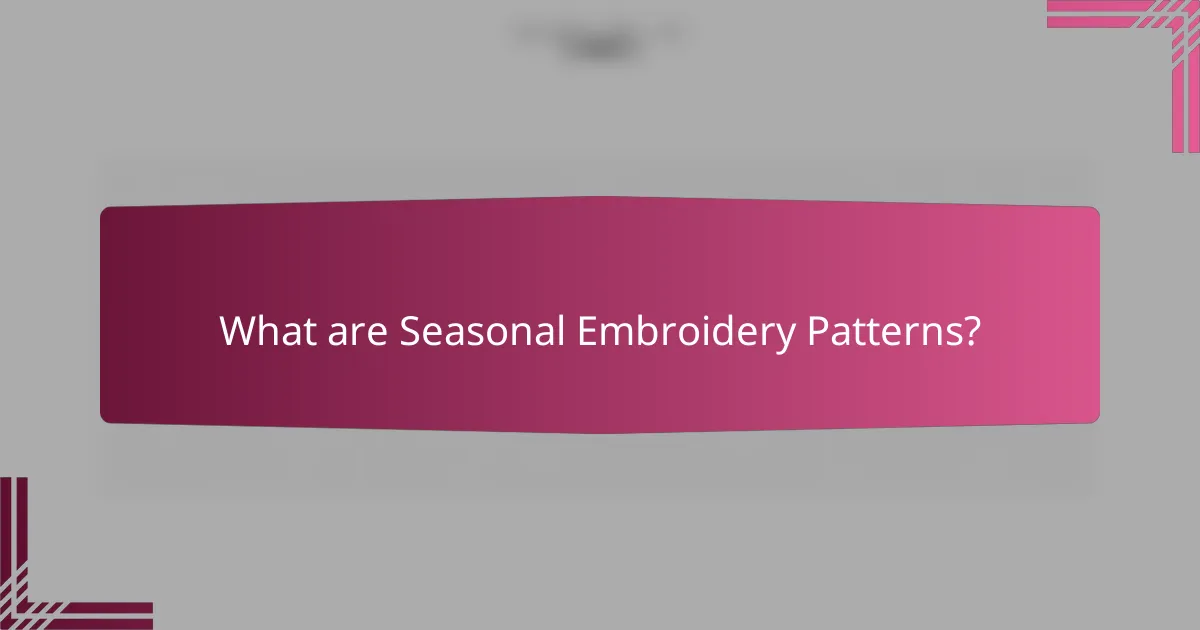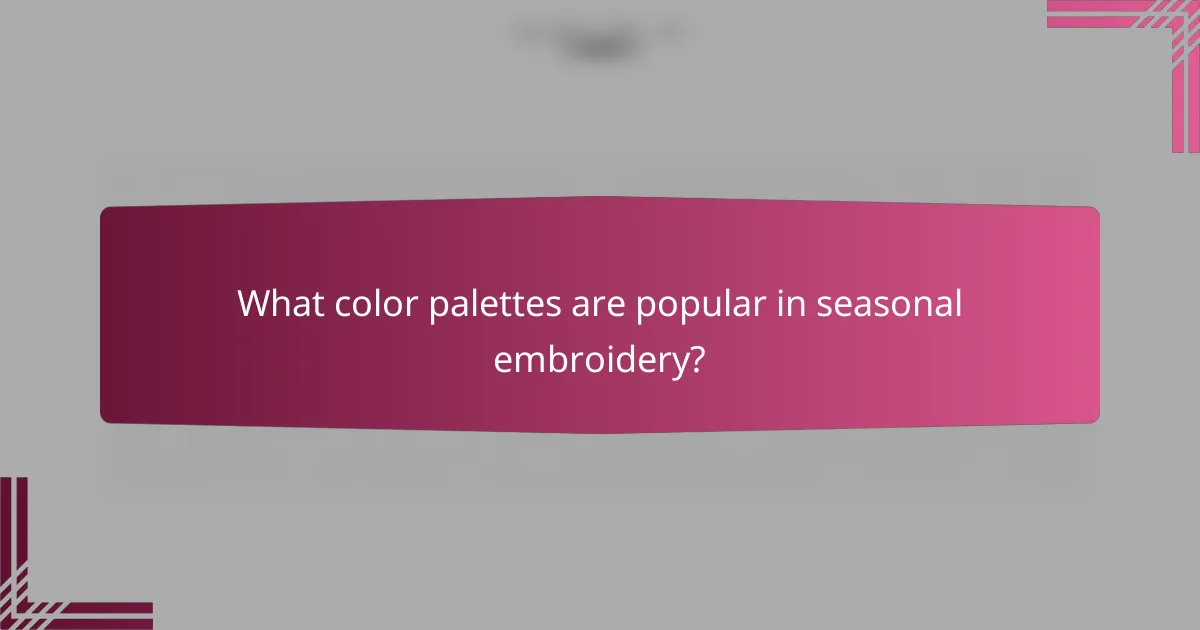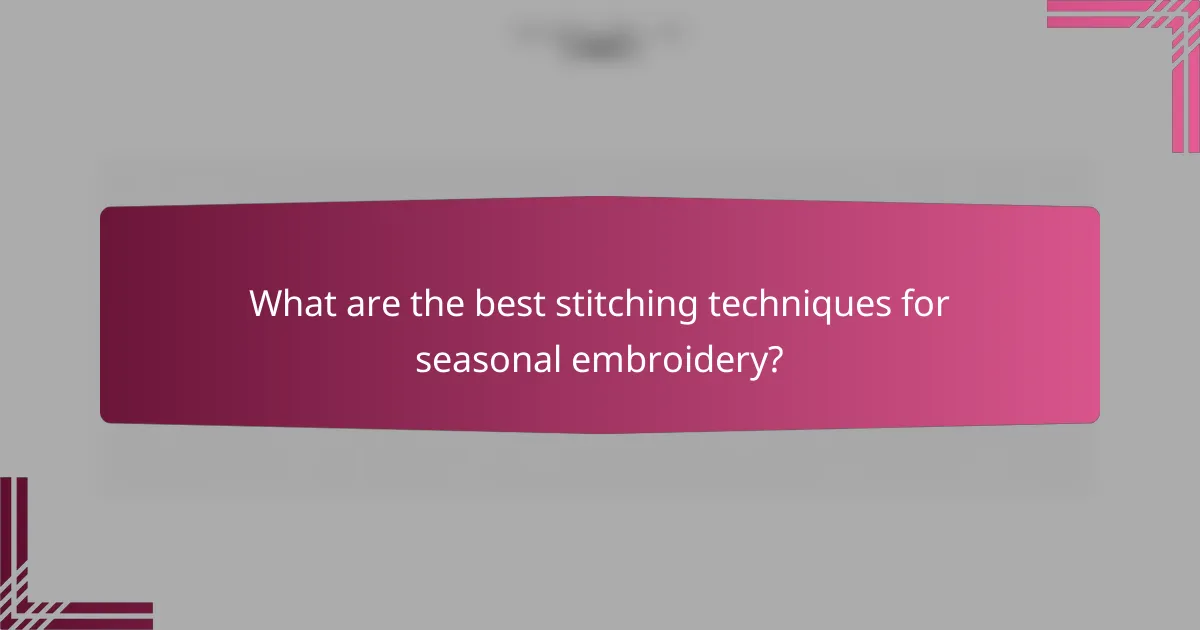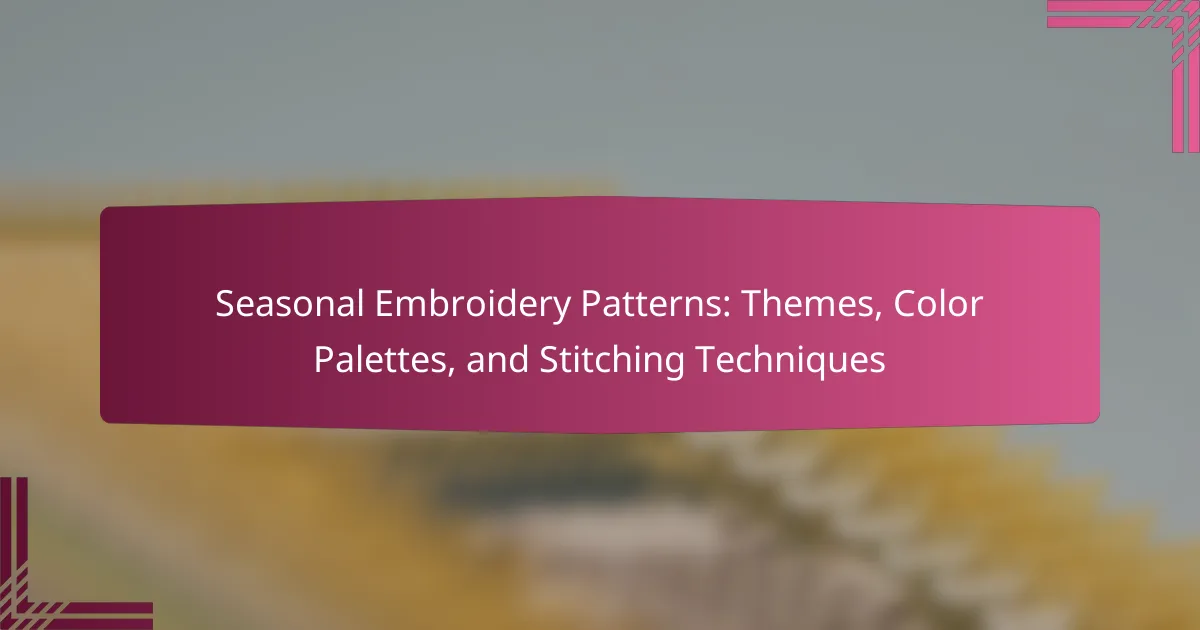
What are Seasonal Embroidery Patterns?
Seasonal embroidery patterns are designs created to reflect the characteristics of specific seasons. These patterns often incorporate themes, colors, and motifs associated with spring, summer, autumn, or winter. For example, spring patterns may feature flowers and pastel colors. Summer designs might include bright colors and beach-related motifs. Autumn patterns often showcase leaves and warm hues. Winter designs can include snowflakes and cool colors. Seasonal embroidery patterns enhance the aesthetic of textiles by aligning with seasonal changes. They are commonly used in home decor, clothing, and accessories.
How do seasonal themes influence embroidery patterns?
Seasonal themes significantly influence embroidery patterns by dictating the motifs, colors, and techniques used. For example, spring often features floral designs and pastel colors. Summer may incorporate vibrant hues and beach-related symbols. Autumn typically showcases warm tones like orange and brown, with leaf motifs. Winter patterns often include snowflakes and cool colors like blue and white. These seasonal influences reflect the natural changes in the environment. Historical embroidery practices also reveal that artisans adapted designs to celebrate seasonal festivals and traditions. This adaptability ensures that embroidery remains relevant and culturally significant throughout the year.
What are common themes associated with each season?
Spring themes include renewal and growth. This season often features floral patterns and pastel colors. Nature awakens, symbolizing new beginnings. Summer themes emphasize warmth and vibrancy. Bright colors and sun motifs are prevalent. Activities like beach outings inspire the designs. Autumn themes reflect harvest and change. Rich, warm colors like orange and brown dominate. Leaves and pumpkins are common motifs. Winter themes focus on coziness and celebration. Cool colors and snowflakes are typical. Holiday symbols like Christmas trees appear frequently. Each season’s themes significantly influence embroidery patterns and color choices.
How do cultural influences shape seasonal embroidery themes?
Cultural influences significantly shape seasonal embroidery themes through traditions, symbols, and colors. Different cultures celebrate unique seasonal events, which inspire specific motifs in embroidery. For example, spring themes often feature floral designs in many cultures. In contrast, winter themes may incorporate snowflakes or holiday symbols.
Regional materials also affect design choices. The availability of certain threads or fabrics can influence the patterns created. Cultural narratives and folklore further enrich these themes, embedding stories within the embroidery.
Historical contexts play a role as well. Traditional techniques passed down through generations often reflect cultural identity. For instance, the use of specific stitching techniques can be tied to a region’s history. Overall, cultural influences create a diverse and rich tapestry of seasonal embroidery themes.
What are the key elements of seasonal embroidery patterns?
The key elements of seasonal embroidery patterns include themes, color palettes, and stitching techniques. Themes reflect the characteristics of each season, such as floral designs for spring or snowflakes for winter. Color palettes are chosen based on seasonal colors, like pastels for spring or warm tones for autumn. Stitching techniques vary to enhance the design, including satin stitches for smooth areas and back stitches for outlines. These elements work together to create visually appealing and contextually relevant embroidery.
What types of stitches are commonly used in seasonal embroidery?
Common types of stitches used in seasonal embroidery include satin stitch, backstitch, and chain stitch. Satin stitch is often used for filling shapes with color. Backstitch provides a strong outline for designs. Chain stitch creates a decorative, textured effect. Other stitches like French knots add dimension. Each stitch serves a specific purpose in enhancing seasonal themes. These stitches are widely recognized in embroidery practices. Their versatility allows for creative expression in seasonal designs.
How does the choice of fabric impact seasonal embroidery designs?
The choice of fabric significantly impacts seasonal embroidery designs. Different fabrics offer varying textures, weights, and absorbency. For instance, lightweight fabrics like cotton are ideal for spring designs, allowing for delicate, intricate patterns. In contrast, heavier fabrics such as wool are suited for winter designs, providing warmth and durability.
Additionally, the fabric’s color and pattern can influence the overall aesthetic. Bright, vibrant fabrics may enhance summer themes, while muted tones can complement autumn designs. The embroidery technique also varies with fabric type; some fabrics require specific stitches to maintain structure.
The interaction between fabric and thread type is crucial. For example, silk threads may shine beautifully on satin fabrics, while cotton threads perform better on canvas. Overall, the fabric choice dictates the design’s feasibility, visual impact, and seasonal relevance.

What color palettes are popular in seasonal embroidery?
Popular color palettes in seasonal embroidery include warm tones for autumn, pastel shades for spring, vibrant colors for summer, and cool hues for winter. Autumn often features deep oranges, browns, and golds. Spring palettes typically incorporate soft pinks, light greens, and yellows. Summer designs often utilize bright blues, reds, and yellows. Winter embroidery frequently showcases icy blues, whites, and deep greens. These palettes reflect the seasonal changes and are frequently used in various embroidery projects to enhance thematic relevance.
How do colors reflect the essence of each season?
Colors reflect the essence of each season through their inherent associations and emotional impacts. Spring is characterized by pastel shades like soft pinks and greens, symbolizing renewal and growth. Summer showcases vibrant hues such as bright yellows and deep blues, representing warmth and vitality. Autumn is marked by earthy tones like oranges, reds, and browns, evoking harvest and change. Winter features cool colors like whites and blues, reflecting tranquility and stillness. These color associations align with nature’s transformations during each season, influencing artistic expression in various forms, including embroidery patterns.
What are the typical color schemes for spring embroidery patterns?
Typical color schemes for spring embroidery patterns include pastel shades and vibrant hues. Common colors are soft pinks, light blues, pale yellows, and fresh greens. These colors reflect the blooming flowers and new growth of the season. Bright colors like coral and lavender are also popular. Many patterns incorporate floral motifs, which enhance the spring theme. The use of these colors creates a cheerful and uplifting aesthetic. Spring embroidery often features combinations of these shades for a harmonious look. The color choices evoke feelings of renewal and freshness associated with springtime.
Which colors are favored in autumn-themed embroidery?
Autumn-themed embroidery typically favors warm colors such as orange, red, and yellow. These colors reflect the changing leaves and the overall essence of the season. Earthy tones like brown and olive green are also popular, representing the harvest and natural elements. Additionally, deep shades like burgundy and mustard can enhance the autumn aesthetic. These color choices are often inspired by the vibrant landscape during fall. The use of these colors creates a cozy and inviting atmosphere in embroidery designs.
What role do color combinations play in seasonal embroidery?
Color combinations are crucial in seasonal embroidery as they evoke specific moods associated with each season. For instance, warm colors like reds and oranges are often used for autumn designs to reflect the changing leaves. In contrast, cool colors such as blues and whites are popular in winter patterns, symbolizing snow and ice.
These color choices can enhance the emotional impact of the embroidery. Research indicates that colors can influence feelings and perceptions. A study published in the Journal of Color Research found that color combinations can significantly affect people’s emotions and preferences.
Thus, selecting appropriate color combinations in seasonal embroidery not only aligns with seasonal themes but also enhances the overall aesthetic and emotional resonance of the artwork.
How can contrasting colors enhance embroidery designs?
Contrasting colors enhance embroidery designs by creating visual interest and depth. They allow different elements to stand out against each other. This contrast can guide the viewer’s eye and highlight specific features of the design. For example, a bright yellow thread against a dark blue fabric makes the embroidery pop. Studies show that high contrast can improve the aesthetic appeal of textile art. Additionally, contrasting colors can evoke emotions and set a mood. This technique is widely used in various embroidery styles to achieve a striking effect.
What are some tips for choosing harmonious color palettes?
To choose harmonious color palettes, consider using the color wheel as a guide. Complementary colors, which are opposite each other on the wheel, create strong contrast. Analogous colors, found next to each other, provide a serene look. Triadic color schemes involve three evenly spaced colors for balance. Limit your palette to three to five colors for simplicity. Test colors in different lighting to see how they interact. Use neutral colors to balance vibrant hues. Finally, consider the emotional impact of colors on your design. These tips help create visually appealing and cohesive color palettes.

What are the best stitching techniques for seasonal embroidery?
The best stitching techniques for seasonal embroidery include satin stitch, backstitch, and French knots. Satin stitch provides a smooth, filled appearance ideal for floral designs. Backstitch creates defined outlines and is perfect for intricate patterns. French knots add texture and dimension, making them suitable for seasonal motifs like snowflakes or flowers. These techniques are commonly used in seasonal embroidery projects to enhance visual appeal. Each technique can be adapted for various themes, ensuring versatility across different seasons.
How do different stitching techniques affect the final look?
Different stitching techniques significantly influence the final look of embroidery. Techniques like satin stitch create a smooth, shiny finish. This results in a polished appearance suitable for decorative elements. Conversely, a chain stitch offers a textured and dimensional effect. This adds depth and visual interest to the design.
Techniques such as cross-stitch produce a more rustic and traditional look. This style is often used in folk art and home decor. Additionally, the use of varying thread thickness can alter the overall impact. Thicker threads can provide bold outlines, while finer threads create delicate details.
The choice of stitching technique also affects color blending. Techniques like blending or shading stitches can create gradients. This enhances the vibrancy and complexity of the color palette. Each technique contributes uniquely to the overall aesthetic of the embroidery piece.
What are the most popular stitching techniques for beginners?
The most popular stitching techniques for beginners include running stitch, backstitch, and whip stitch. Running stitch is a simple technique that involves making small, even stitches in a straight line. Backstitch creates a strong line by stitching backward, making it ideal for outlines. Whip stitch is used for joining two pieces of fabric together, often at the edges. These techniques are foundational and widely taught in embroidery classes. They provide a solid base for more complex designs. Many beginners find these stitches easy to master and versatile for various projects.
How can advanced techniques elevate seasonal embroidery projects?
Advanced techniques can significantly elevate seasonal embroidery projects by enhancing detail and complexity. Techniques such as layering and dimensional stitching add depth to designs. For instance, 3D embroidery creates a textured effect that captures attention. Advanced color blending techniques can produce gradients that mimic natural seasonal changes. Using specialty threads, like metallic or variegated, can introduce visual interest. Incorporating machine embroidery can increase precision and speed, allowing for intricate patterns. Research shows that projects utilizing advanced techniques often receive higher appreciation in craft communities. These methods not only improve aesthetics but also expand creative possibilities.
What tools and materials are essential for seasonal embroidery?
Essential tools and materials for seasonal embroidery include embroidery floss, fabric, needles, and hoops. Embroidery floss comes in various colors and is used for stitching. Fabric types vary, such as cotton or linen, providing a suitable base for designs. Needles should be sharp and appropriate for the chosen fabric. Hoops keep the fabric taut during stitching. Additional items like scissors, marking tools, and stabilizers enhance the embroidery process. These tools and materials are widely recognized as necessary for effective seasonal embroidery projects.
What types of needles are best for various fabrics?
Universal needles are best for general sewing on woven and knit fabrics. They have a slightly rounded point that prevents snagging. For delicate fabrics like silk, use a fine needle, such as a size 60/8 or 70/10. These needles have a smaller diameter to avoid damaging the fabric. For denim or heavy fabrics, a jeans needle is ideal. This needle has a thicker shaft and a strong, sharp point. For knits, a ballpoint needle is recommended. It has a rounded tip that slides between fibers without breaking them. Specialty needles exist for specific tasks, such as embroidery needles for decorative stitching. These needles have a larger eye to accommodate thicker threads. Choosing the right needle enhances stitching quality and fabric integrity.
How do thread types impact the quality of embroidery?
Thread types significantly impact the quality of embroidery. Different thread materials, such as polyester, rayon, and cotton, each have unique characteristics. Polyester threads are durable and resistant to fading, which enhances the longevity of the embroidery. Rayon threads offer a shiny finish and vibrant colors, improving visual appeal. Cotton threads provide a matte look and are often preferred for traditional designs. The thread weight also affects the stitch density and overall texture. Thicker threads create bold, pronounced designs, while thinner threads allow for delicate details. Choosing the appropriate thread type ensures optimal stitch quality and enhances the final appearance of the embroidery.
What are some practical tips for creating seasonal embroidery patterns?
To create seasonal embroidery patterns, choose themes that reflect the specific season. For spring, consider floral designs and pastel colors. In summer, opt for bright colors and beach motifs. Autumn patterns can feature leaves and warm tones. Winter designs may include snowflakes and cool colors. Select a color palette that aligns with seasonal themes. Use fabric that complements the chosen colors and designs. Experiment with different stitching techniques to enhance texture. Incorporate seasonal symbols for added meaning and relevance. Keep your designs simple for easy execution and wider appeal.
How can one effectively plan a seasonal embroidery project?
To effectively plan a seasonal embroidery project, start by selecting a theme that reflects the season. Consider using motifs such as flowers for spring or snowflakes for winter. Next, choose a color palette that aligns with your theme and season. For example, pastel colors work well for spring, while warm tones suit autumn.
Then, outline the specific stitches and techniques you will use. Research various embroidery stitches that complement your design. Create a timeline for project completion, breaking it down into manageable steps. Gather all necessary materials, including fabric, threads, and tools, before beginning.
Finally, set aside dedicated time for stitching to maintain momentum and stay on track. Planning in this structured way enhances the likelihood of completing a successful seasonal embroidery project.
What are common mistakes to avoid in seasonal embroidery?
Common mistakes to avoid in seasonal embroidery include not planning the design properly. Failing to consider the seasonal theme can lead to mismatched colors and patterns. Ignoring fabric choice can result in poor stitch definition. Not using the right thread type may cause fraying or fading. Skipping test stitches can lead to unexpected results on the final piece. Underestimating the time required for complex designs can cause rushed work. Neglecting to clean the embroidery area can introduce dust and debris into the project. Lastly, overlooking care instructions for finished pieces can result in damage during washing or storage.
Seasonal embroidery patterns are designs that reflect the characteristics of specific seasons, incorporating themes, colors, and motifs associated with spring, summer, autumn, and winter. This article explores how seasonal themes influence embroidery through key elements such as color palettes, stitching techniques, and cultural influences. It also discusses the impact of fabric and thread choices on the quality of embroidery, practical tips for creating seasonal designs, and common mistakes to avoid. Overall, the content provides a comprehensive overview of how to effectively plan and execute seasonal embroidery projects.
